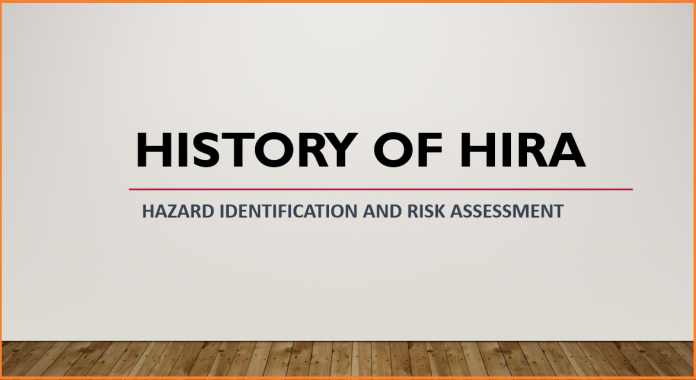Hazard Identification and Risk Assessment (HIRA) is a very important component of safety management systems across various industries. The history of HIRA is deeply intertwined with the evolution of safety practices, reflecting a growing awareness of the need to systematically identify and manage potential hazards to ensure the well-being of individuals and the integrity of operations. This article explores the historical development of HIRA, tracing its origins, key milestones, and its role in shaping modern safety protocols.
Early Safety Practices:
The roots of HIRA can be traced back to the early days of industrialization when workplace safety was often neglected. The prevalence of accidents and injuries led to the realization that a systematic approach was required to identify potential hazards and mitigate associated risks. Early safety efforts primarily focused on reactive measures rather than proactive hazard identification.
Emergence of Systematic Risk Assessment:
The mid-20th century marked a significant shift in safety consciousness. Industries, particularly those in the chemical and nuclear sectors, recognized the need for a more systematic approach to identify and assess potential hazards. Engineers and safety professionals began developing methods to evaluate risks associated with complex processes and technologies.
Development of Quantitative Risk Assessment (QRA):
In the latter half of the 20th century, the concept of Quantitative Risk Assessment (QRA) gained prominence. This approach involved the use of mathematical models to quantify the probability and consequences of potential hazards. QRA allowed for a more precise evaluation of risks, enabling organizations to prioritize safety measures based on a scientific understanding of potential outcomes.
Integration of HIRA into Safety Management Systems:
As safety management systems (SMS) gained popularity, HIRA became an integral part of these frameworks. Organizations started adopting proactive measures, emphasizing hazard identification as a foundational step in risk management. HIRA evolved to include not only quantitative assessments but also qualitative methods, allowing for a comprehensive analysis of hazards across various domains.
International Standards and Regulations:
The late 20th century and early 21st century saw the development of international standards and regulations that emphasized the importance of systematic hazard identification and risk assessment. Organizations worldwide began aligning their safety practices with standards such as ISO 45001, ISO 31000 and IEC 61511, further emphasizing the global recognition of HIRA as a crucial element in safety management.
Technological Advances in HIRA:
Advancements in technology have played a crucial role in enhancing the effectiveness of HIRA. The development of computer-based tools, simulation software, and artificial intelligence applications has enabled organizations to conduct more sophisticated and accurate hazard assessments. These tools facilitate the analysis of complex systems and help identify potential hazards in diverse environments.
21st Century: HIRA Integration with EHS Management Systems
In the 21st century, HIRA has become an integral part of Environmental, Health, and Safety (EHS) management systems. The integration of HIRA with broader safety frameworks ensures a holistic approach to risk management. Advanced technologies such as artificial intelligence, data analytics, and machine learning have further enhanced the accuracy and efficiency of HIRA processes.
Challenges and Future Trends
While HIRA has come a long way, challenges persist. Rapid technological advancements bring both opportunities and risks, requiring continuous adaptation of risk assessment methodologies. Additionally, globalization has led to the incorporation of diverse perspectives in risk assessment, necessitating a more inclusive approach.
Looking ahead, the future of HIRA will likely involve increased automation, real-time monitoring, and a more proactive stance toward emerging risks. The ongoing evolution of safety standards and the integration of HIRA into emerging technologies will be crucial in ensuring a safer and more sustainable future.
The history of HIRA in safety management is a testament to the evolving understanding of the importance of proactive hazard identification and risk assessment. From rudimentary safety measures to the integration of advanced technological tools, HIRA has come a long way in ensuring the safety and well-being of individuals and the sustainability of various industries. As we move forward, ongoing developments in technology and a commitment to continuous improvement will likely shape the future of HIRA in safety management systems.





